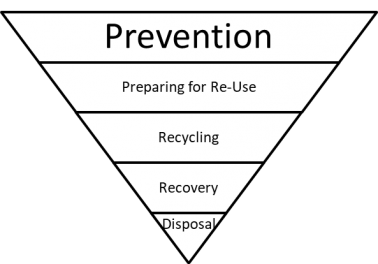3.3. 3. Die Plastiktüte - Symbol unserer Wegwerfgesellschaft?
Im Jahr 2013 wurden EU-weit 98.6 Milliarden Plastiktüten konsumiert; das bedeutete einen Durschnitt von 198 Plastiktüten pro EU-Bürger*in. Mit Blick auf diese Zahlen könnte man sagen, dass die Plastiktüte ein (ehemaliges) Symbol unserer Wegwerfgesellschaft und unseres nicht-nachhaltigen Lebensstils manifestiert. Das größte Problem an Plastiktüten - und Plastik im Allgemeinen - ist deren lange Überlebensdauer in der Umwelt; es dauert tausende von Jahren bis Plastiktüten von selbst abgebaut werden.
Seit 2013 sucht die Europäische Kommission nach Möglichkeiten eine Antworte auf die Frage "How can we reduce marine litter?" zu finden. Die erste Gesetzgeberische Maßnahme hierzu war die Verordnung zur Plastiktüte im Jahr 2015. Die Verordnung wurde 2013 von der Europäischen Kommission vorgeschlagen und im Jahr 2015 vom Europäischen Parlament und dem Ministerrat verabschiedet. Die Verordnung setzt auf die Vermeidung von Plastikmüll. Das EU-Gesetz veranlasst Mitgliedsstaaten Maßnahmen zur Reduktion des Konsums von Plastiktüten zu unternehmen. Es können dafür vor allem wirtschaftliche Maßnahmen herangezogen werden, wie die Besteuerung von Plastiktüten oder eine Gebühr beim Kauf an der Kasse. Die Begründung des Gesetzes verweist auch auf die Maßnahme der Bewusstseinsschaffung und Bildungsangeboten, ohne diese näher auszuführen. Insgesamt steht die Verordnung zur Plastiktüte im Einklang mit der 'EU-waste management hierarchy' aus dem Jahr 2008. Diese Hierarchie beschreibt ein Prioritätenranking für den Umgang mit Müll und Abfällen.
Figure 2. The EU-waste management hierarchy (EC,2008)
Insgesamt kann diese Verordnung als ein erster richtiger Schritt angesehen werden. Es ist allerdings bei weitem nicht genug um die übergeordnete Problematik zu lösen. Plastiktüten sind nur eine von vielen Quellen von Plastikmüll. Da die Plastiktüte als Symbol unserer Wegwerfgesellschaft gesehen werden kann, handelte es sich 2015 auch um bloße Symbolpolitik.
Single-Use Plastic Bags – The (Former) Symbol of Our ‘Throw-Away Society’
Overall 98.6 billion plastic bags were consumed EU-wide in 2013; that meant an average of 198 bags per EU citizen. Looking at these numbers, one could say that the plastic bag is the symbol of our throw-away society and unsustainable lifestyles. The biggest environmental problem of plastic bags and plastic in general is their proliferation in the environment; they take thousands of years to decompose. As said before, they easily escape the waste management streams and accumulate in our environment, often as marine litter (EC 2015a).
In October 2013 the European Commission initiated a public consultation targeting the question How can we reduce marine litter?. Its overall aim was to explore measures that could be undertaken by, among others, consumers, retailers, the plastic industry, shipping and fishing companies, NGOs, national governments and EU policy-makers to reduce the presence and impact of marine litter. The results included options such as avoiding the consumption of single use plastic bags and plastic bottles, awareness-raising, clean-up actions and setting reduction targets at national or local level (EC, 2013).
The first legislative outcome of this public consultation concerning plastics was a directive to reduce the consumption of lightweight plastic bags by the European Commission. Light weight plastic bags are carriers with a thickness below 0.05 mm. This threshold is supposed to ensure higher reuse of thicker carriers and lower littering rates. The directive was proposed in November 2013 and passed by the European Parliament in April 2015. Officially the bill was an amendment to the Packaging and Packaging Waste Directive. Concerning prevention, the amendment requires member states to take measures to reduce the consumption of lightweight plastic bags by using economic instruments such as taxes or levies, national reduction targets and marketing restrictions. The explanatory statement of the directive also mentions awareness-raising and educational programs (EC, 2015a). Article 1 of the directive stipulates that either “the annual consumption level does not exceed 90 lightweight plastic carrier bags per person by 31st December 2019 and 40 lightweight plastic carrier bags per person by 31st December 2025 […]”(EC, 2015a), or “the adoption of instruments ensuring that, by 31st December 2018, lightweight plastic carrier bags are not provided free of charge at the point of sale of goods or products […]”(EC, 2015a).
Generally speaking, the plastic bag directive is in line with the EU Waste Framework Directive published in 2008. In accordance with the EU-Waste Management Hierarchy the directive aims at the prevention and the reduction of the consumption of plastic bags. The Waste Management Hierarchy introduces a priority order to be applied for waste legislation and policy of the EU Member States (EC, 2008).
From an environmental point of view the directive follows the precautionary principle; the polluter pays principle and the extended producer responsibility are not applied. Moreover, the directive relies more on economic measures such as fees, than on awareness-raising strategies to change the consumption patterns of consumers.
Bottom line, the directive was a first and well-meant step into to the right direction. But it was by far not enough to solve the largescale problem. Plastic bags are just one of many sources of marine waste, there are no clear-cut rules for the member states of how to implement the amendment and the directive contains several other loopholes. Hence, as the plastic bag can be seen as a symbol of the throw-away society, this amendment can be seen as symbolic politics.
